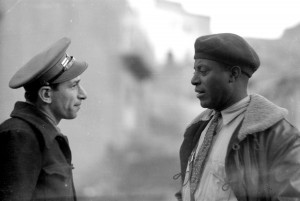The Lincoln Brigade and racial justice: A tradition

Abraham Lewis (r) of the Brigade Commissariat, with Chief of Auto Park Louis Secundy, Dec. 1937 (Tamiment Library, NYU, 15th IB Photo Collection, Photo # 11-1010)
“I had read Hitler’s book, knew about the Nuremberg laws,” recalled Vaughn Love, a volunteer from Harlem in New York, “and I knew if the Jews weren’t going to be allowed to live, then certainly I knew the Negroes would not escape and that we would be at the top of the list. I also knew that the Negro community throughout the United States would be doing what I was doing if they had the chance.”
When Mussolini’s troops joined Franco’s side in Spain, African Americans saw an opportunity to strike back. In Chicago, James Yates and his friend Alonzo Watson concluded “Ethiopia and Spain are our fight” and prepared to leave for Spain. For Vaughn Love, “fascism is the enemy of all black aspirations” and he could not wait to “get to the front and kill these fascists.” In Spain, Oliver Law told a journalist, “We came to wipe out the fascists; some of us must die doing that job. But we’ll do it here in Spain, maybe stopping fascism in the United States too, without a great battle there.”
Some African American recruits brought unusual skills to the fight against fascism. In 1937 when the United States only had five licensed African American pilots, two of them, James Peck and Paul Williams, volunteered to challenge the fascists in the air. In the United States they held commercial licenses but found their careers frustrated. In Spain they found action. Another African American, Dr. Arnold Donowa, a Harvard graduate and noted dental surgeon, brought his surgical skills. As head of the Medical Corps’ Oral Surgery Unit, he often operated without “a drop of Novocain” and “a lack of instruments and supplies needed for adequate jaw surgery. And frequently we had not even enough gauze and bandages to dress the wounds of the men.” Albert Chisholm, arrived in Spain from Washington where he had drawn political cartoons for the Northwest Enterprise, a Seattle African American newspaper. Chisholm gladly contributed his work to the International Brigade newsletter, Our Fight. Burt Jackson was a skilled mapmaker at Fifteenth Brigade headquarters. From Harlem hospital in New York, Nurse Salaria Kea joined 70 other American women who volunteered to serve in the American Medical Bureau.
In Spain, African Americans served equally at all levels. Oliver Law and Walter Garland were the first black officers in U.S. history to command white soldiers in battle. And like other nationality groups in the International Brigades, African Americans sacrificed their lives in this first fight against fascism.
During World War II, African American Lincoln veterans also enlisted in the U.S. Army. There they discovered the enduring discrimination of Jim Crow policies. Even the Red Cross segregated “colored” blood from “white” blood. Many Lincoln veterans, white and black, protested such military policies, contrasting their second-class status in America to the equality they had found in Spain.
After World War II, Lincoln veterans participated in the civil rights protests throughout the south and north. Lincoln brigadistas were prominent in the notorious 1950s cases of Willie McGee and the Trenton Six in which black men were falsely accused of raping white women. Some like Abe Osheroff and Ruth Davidow joined the Mississippi Freedom Summer project of 1964. Many marched in the streets of New York, Chicago, San Francisco, Los Angeles—indeed, wherever they saw racial discrimination. And many of their children and grandchildren joined in those campaigns and remain advocates for racial justice today.













Thank you for this. I live in Spain and have thought highly of the Brigade since first reading about it on my first visit here in the 1960s. Some time ago I started using a group picture of the Brigade as wallpaper, apart from visiting some areas that saw battle. I noticed the Black volunteers and was struck by the fact that at that time and in that historical context, Black Americans should volunteer to fight fascism in Spain. I feel these fine men deserve great honor and respect. It is good to learn their names.